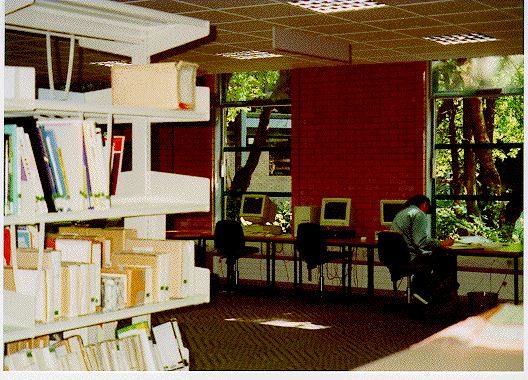Down Your Way: Edge Hill University
Edge Hill University College [*] is beautifully situated in the historic little market town of Ormskirk. The leafy 70 acre campus was purpose-built in the 1930s, when the college moved from the Edge Hill area of Liverpool. The college has seen many changes since the move, not least in its transition from being a Women's Teacher Training College to its current status as a university-level institution providing a range of degree courses. Teacher training still accounts for around 30% of course provision, but the institution now offers a range of courses for its 4,500 full time equivalent students. Social sciences are particularly strong, alongside health studies, environmental sciences and other more recent additions.
Growth in student numbers has meant that the lovely symmetrical 1930s buildings have now been joined by several more modern buildings. A purpose-built Learning Resource Centre was completed over two years ago, opening in January 1994. Its 4,500 square metres are on three levels, giving students access to group and individual study areas, with specially adapted rooms available to disabled students. Throughout the college the student to PC ratio is a very low 7:1. The Learning Resources Centre has a total of 150 PCs open to student access, with more being added during my visit.

The Library is reliant upon the good relationship which it has built with Computer Services. Computer Services is based within the Student Information Centre. Another 130 PCs are found in this building, which includes "drop in" facilities and bookable areas for teaching purposes. This separation gives the Library an enviable degree of control over its PC rooms, which are designed to be used mainly for student group work and individual student use.
Joint planning of information and learning support services in the institution takes place through a federation known as ASSIST ("Access for Students and Staff to Information Services and Technology"). It comprises Library Services, Computer Services, MediaTech Services, and Teaching and Learning Development. The latter provides support for students in study skills, running sessions on exam technique, coursework preparation and so on, but of the four services it is Computer Services which currently runs the most extensive programme of IT training courses. Available on a voluntary basis, students can join sessions which include an introduction to the network, word-processing, spreadsheets and Web training.
It is in this latter area that the Library sees a potential complementary role for itself. A programme of workshops is currently being prepared in effective information retrieval over the Web, building upon the introductory course offered by Computer Services. The Library currently provides the usual induction training to students - in OPAC use and CD-ROM searching. For next session it hopes to formalise this training and to give both an introduction to CD-ROMs and a more advanced session dealing with downloading records and how to process the information found.
The College Web pages are the responsibility of Computer Services. The Library's pages were put together initially by a student on a placement from John Moores University, Liverpool. Library staff worked with him to produce the pages, which went live when the new Resource Centre was opened.
Since the launch the Library has become concerned about the exploitation and arrangement of resources on the college Web pages. Currently, links to resources are provided though the college's pages rather than through the Library's own. As in many institutions, the design of what is in large part an information service has been entrusted to a unit of the organisation which lacks the depth of experience in information structure which Library staff could bring. Library input is required to arrange the resources logically by subject, and to provide the metadata.
Strong links have been built up by the Library with the various academic Schools, and each professional librarian on the staff has a liaison role with one of the Schools. The librarians are currently working on individual subject pages for their School, but finding the time to do the development work required can be very difficult. They have all been given some basic instruction in HTML-encoding and one of the staff is designated Library Web Editor, with responsibility for checking all pages before they go live.
Edge Hill caters well for a student body which requires a high degree of access to learning materials and networked PCs. Even so, current provision is not sufficient to meet the constantly growing demand. Students, particularly part-time students who make up a high proportion of the total, have requested longer opening hours.
"We extended opening at weekends last session" said Cathy Burns, who showed me round the Resource Centre on a quiet afternoon during the summer vacation. "Now the students want later evening access. The demand just keeps on rising. We seem to be victims of our own success." As we spoke, technicians wheeled in more PCs to be added to the 150 already in the Learning Resource Centre. Edge Hill has clearly joined the university sector at the leading edge of IT provision.
*Editor's note: Since receiving official confirmation of university status in April 2006, the institution is now called Edge Hill University. (23 May 2006) Return to top
